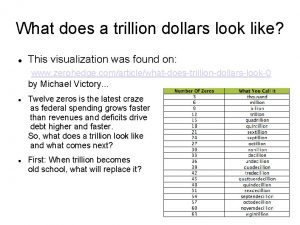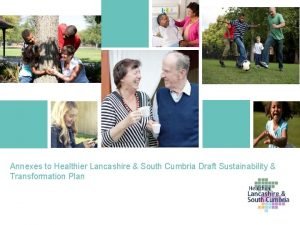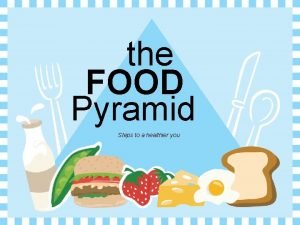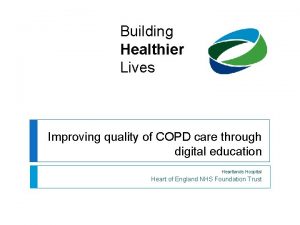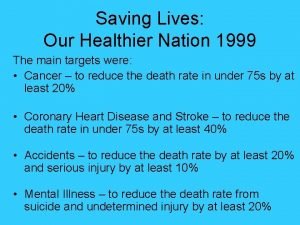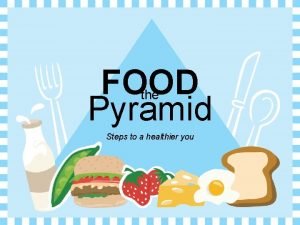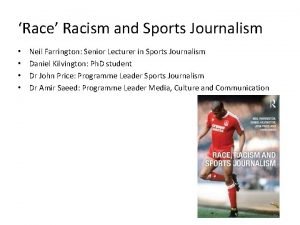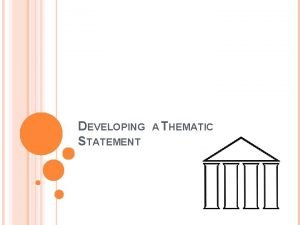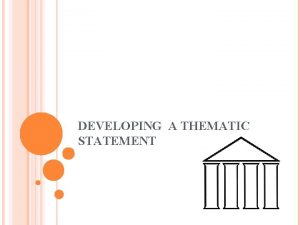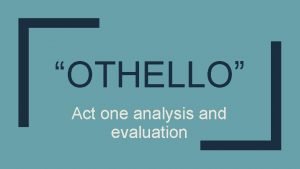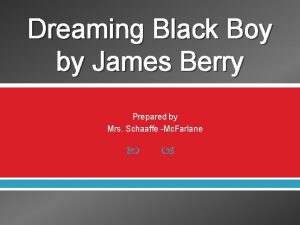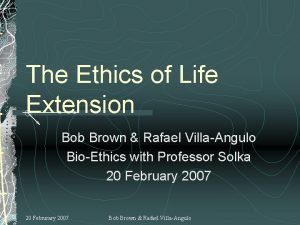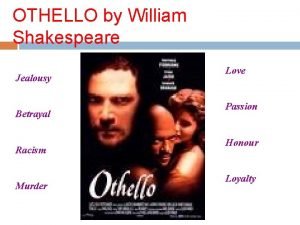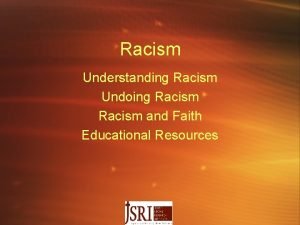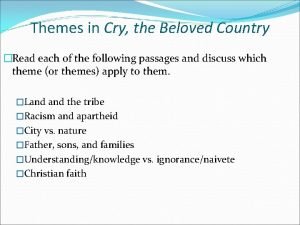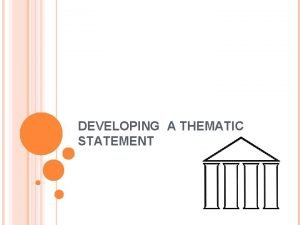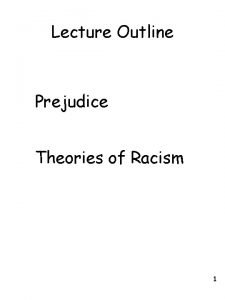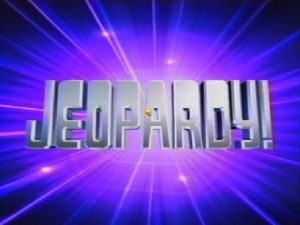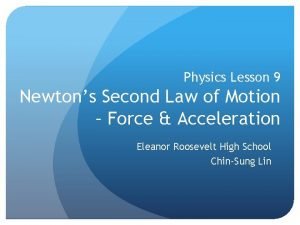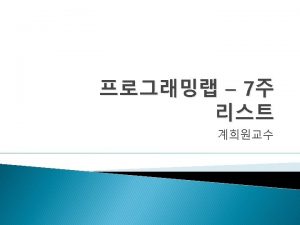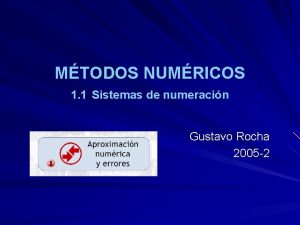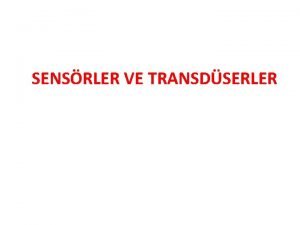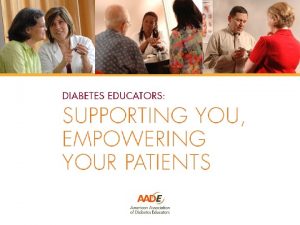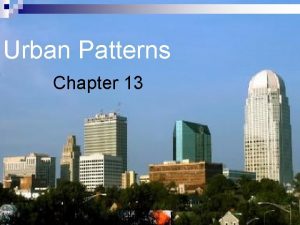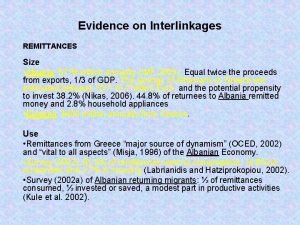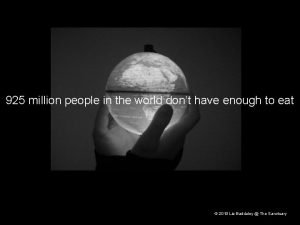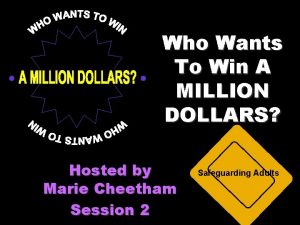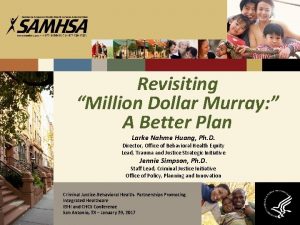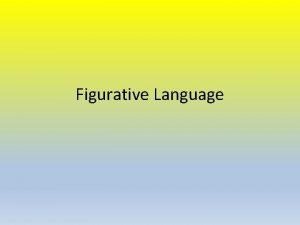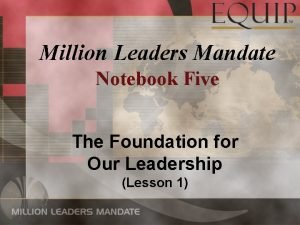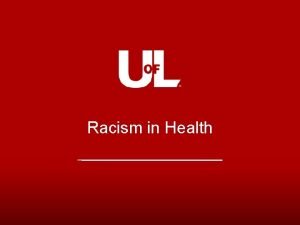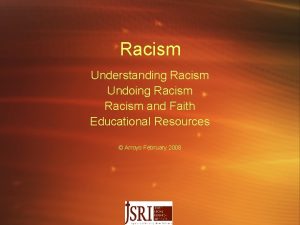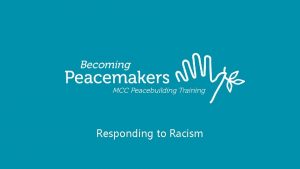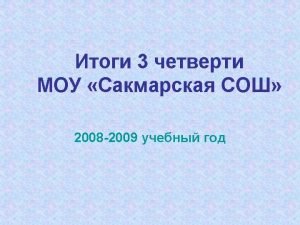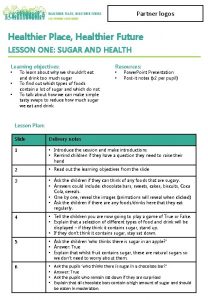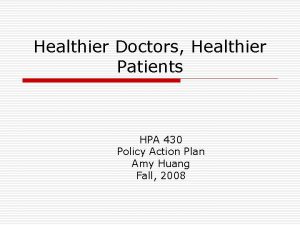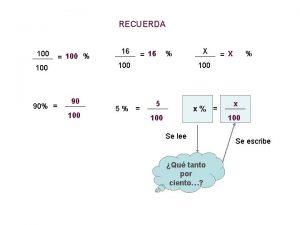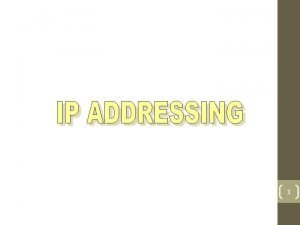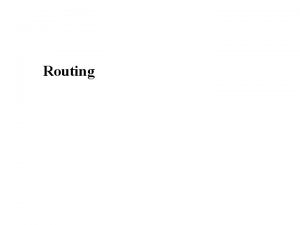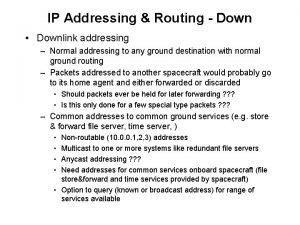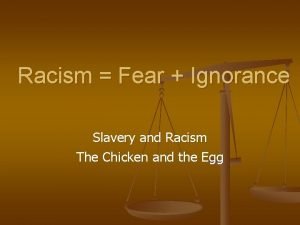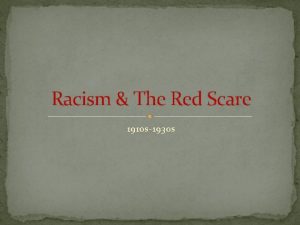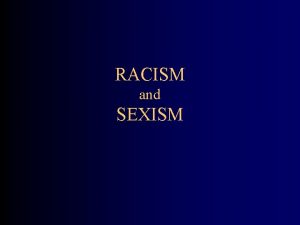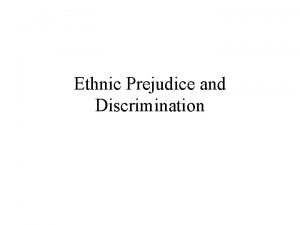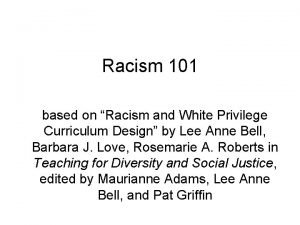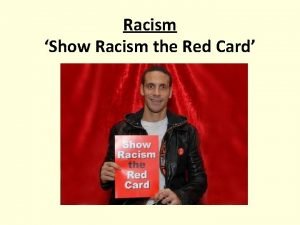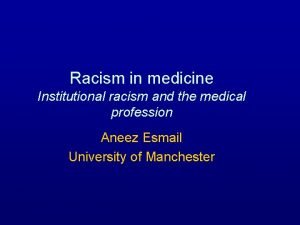1 Addressing Racism Lessons from 100 Million Healthier




















































- Slides: 52

1 Addressing Racism: Lessons from 100 Million Healthier Lives CJA National Conference February 14, 2018

2 Introductions!

Your Turn! 3 Flash Introductions (30 seconds person) ■ Your Name ■ Community you are from ■ Where you work/what you do ■ What do you hope to get out of today’s session that will dramatically change how you or your community addresses racism?

100 MLives Touchstones Shannon Welch

100 Million Healthier Lives Touchstones for Collaboration 5 ● Be present as fully as possible. Speak your truth from your heart and mind. ● Listen generously to each other’s truths. Trust that we all hold a piece of the puzzle and we need each other’s pieces to understand the whole picture. ● Embrace differences and be open to learning from each other. ● When the going gets rough, suspend judgment and get curious. Be quick to forgive and ask open questions to understand. ● Honor each other’s learning and resourcefulness. Trust we will learn and contribute in our own way, that there is not need to “fix” each other.

Touchstones 6 ● Make space to pause and reflect to deepen our thinking. ● Be willing to have meaningful conflict to create unprecedented goals and solutions. When needed, seek council for help with conflicts. ● Allow your ideas to be developed further by others. ● Seek common ground. When we can’t fully agree, commit to a unified decision and see what happens with a humble posture of learning. If we have made the wrong turn, we will discover it together and turn the right way together. ● Accept that we will sometimes fail, but we will learn together and move forward.

Touchstones 7 ● Help each other to have the confidence to spread out wings, be creative and take on new roles. ● Balance our yearning for change with patience in the process of change and growth. ● Make the way we work together an example of what’s possible.

Session Learning Objectives 8 Rational Aims: 1. Become aware of at least one new way to address racism in your work 2. Practice using an equity lens 3. Begin understanding how to look at policy from a racism/equity lens 4. Engage in transformative discussions across cultural and social divides on an interpersonal/group level 5. Understand the concept of cultural humility and power

Session Learning Objectives 9 Experiential Aims: ● Feel more comfortable being uncomfortable having community discussions on racism ● Feel more confident working on policy changes that address racism and increase equity ● Feel uplifted - that addressing racism is possible!

Agenda 10 8: 30 - 8: 55 Introductions, Touchstones, Objectives and Agenda 8: 55 - 9: 05 100 Million Healthier Lives’ Journey to Addressing Racism 9: 05 - 9: 30 Origin Stories 9: 30 - 9: 35 Wellness Now Oklahoma City’s Journey to Addressing Racism 9: 35 - 9: 50 The Community of Solutions Framework 9: 50 - 10: 05 Break 10: 05 - 10: 15 Energizer 10: 15 - 10: 20 Healthier Laramie County’s Journey to Addressing Racism 10: 20 - 10: 40 5 Whys Exercise - Understanding Root Causes 10: 40 - 10: 45 Proviso Partners’ Journey to Addressing Racism 10: 45 - 11: 10 Cultural Humility Exercise 11: 10 - 11: 35 Discriminatory Practices Exercise 11: 35 - 11: 40 Downtown Women’s Center’s Journey to Addressing Racism 11: 40 - 12: 00 Wrap-up and Commitment to next Steps

Overview of 100 MLives

100 Million Healthier Lives www. 100 mlives. org Identity: An unprecedented collaboration of change agents pursuing an unprecedented result: 100 million people living healthier lives by 2020 Vision: to fundamentally transform the way we think and act to improve health, wellbeing, and equity. Equity is the “price of admission. ” Convened by the Institute for Healthcare Improvement as a partnership

Principles Guiding How We Work 13 ● Partner deeply and respectfully in the process of creating change with people, organizations, and communities. ● Promote equity, justice, strength, and wholeness in the process of creating health. ● Adopt a humble posture of learning and improvement that acknowledges the importance of both stories metrics that matter. ● Intentionally work to remove barriers in critical areas (e. g. , payment reform, spread of good ideas) through intentional collaboration with traditional and nontraditional partners. ● Make the way we work an example of what is possible.

Who is In Our Growing Movement: >1100 members in 27+ countries worldwide Interactive Map www. 100 mlives. org/map

15 Our continuing journey to Address Racism

Origin Stories

Origin Story 17 ● An Origin Story is a story of you and where you come from ● It can be a narrative, prose, or poetic in nature

Origin Story Steps 18 ● Use the guiding questions on the next slide to help you think about what you want to include as a part of your story. You do not have to answer every question. ● Pair and Share: Share your story with a partner uninterrupted. Listen attentively to your partner's story ● Large Group Share: Reflect on the experience of writing and listening. What did you learn about yourself and others?

Guiding Questions to Create Your Origin Story 19 ● What is your background/ethnicity/race? ● What foods did you eat growing up? ● What culture do you associate most with? ● What sayings/phrases did you grow up with? ● Where did your ancestors come from? ● How do you celebrate and/or what do your family gatherings look like? ● What is the story of your people/family? ● Where did you grow up? ● In what economic class did you grow up? ● What is your educational background? ● What beliefs/religious practices do you have or hold? ● What traditions did you grow up with? ● What traditions do you keep, which do you not?

Wellness Now Oklahoma City’s Journey to Addressing Racism

Community of Solutions Skills and Behaviors Addressing Racism requires a diverse set of skills and behaviors

SCALE Communities – Overall Content Theory • • • Leading from within (LW) Leading together (LT) Leading for outcomes (LO) Leading for equity (LE) Leading for sustainability (LS) Community of solutions skills Community of solutions behaviors, processes, systems • How people relate to themselves, one another, and to those affected by inequity • How the community approaches the change process • How the community creates abundance • Health as a shared value • Thriving cross-sector partnerships • Healthy, equitable communities • Improved population health, wellbeing and equity outcomes Culture of health outcomes

How people relate to each other and to those who are most affected by inequity 23 ● They have gone from treating a community like a hierarchical organization and see it instead as a living organism made up of connected, interdependent parts - dynamic and responsive interchange between groups and levels ● People with lived experience work together with community connectors and formal leaders to co-design and drive the change ● A critical mass of people see themselves as stewards of the community’s wellbeing, with the agency and capacity to create change ● Leaders across the community work together strategically to create the systems and policies needed to sustain long term change ● They prioritize equity and create a change process that grows equity (ownership) of those with lived experience

How the community creates abundance 24 ● Leaders across sectors in a community coordinate and leverage their assets in usual and unusual ways to address the priority needs of the community, using an anchor institution approach. ● They have the trust and governance processes in place to share resources and accountability ● They prioritize the unlocking of trapped and untapped potential in people and organizations as a pathway to abundance ● They see the development of leaders and their ability to contribute to the solutions at every level of the community as a key part of creating abundance ● They invest in a change process which is dynamic and grows engagement, relationship, capacity, and the will for change

How the community approaches the change process ● They believe change is possible and have a tangible motivating vision. ● They focus on getting to meaningful outcomes for people and places— and adapt what those are, as they learn ● They approach change in a dynamic way - they learn, adapt and fail forward as a normal part of creating change in small and big ways ● They recognize that change can come from anywhere—and create the space for solutions to come from many different places. ● They co-design change from the person and population up with people with lived experience. ● They do not see themselves as terminally unique—and embrace the opportunity to learn from others. They display humility and a willingness to adopt solutions created by others. 25

Leading from Within 26 ● Leading from Within (LW) skills involve one’s inner journey as a leader, including the ability to: • Know yourself and what brings you to leadership • Reflect, “fail forward, ” and change as needed • See and commit yourself to unlocking the leadership of others, especially those with lived experience of inequity and racism • Understand your “origin story” and how this affects your actions, behaviors and preconceived notions • Approach change from a place of abundance • Understand implicit bias • Value difference – Habits of the Heart: (Palmer P. , 2000)

Leading Together 27 ● Leading Together (LT) skills are grounded in the view of the community as a dynamic network of interacting people, organizations, and systems. It is necessary to lead together with others in a community to create effective, equitable change. Elements of Leading Together skills include: • Developing trust, relationships, and interconnectedness • Working through real and perceived power-dynamics and power differentials • Collaboration (including integrating people most affected by inequities and racism in your work) • Co-Designing solutions with people most affected by inequities and racism

Leading for Outcomes 28 ● Leading for Outcomes (LO) skills support communities in applying a core set of skills to more quickly make progress on its priority areas of work. • Innovation/Design Thinking – Using stories and experience to understand the experience of people affected by a change (e. g. structural racism) • Improvement science – Developing aims, drivers, and measures, and running tests of changes • Using Data - understanding who isn’t thriving (including who is affected by structural racism and other structural inequities) • Implementation skills – Making implementation easier, more effective, and more joyful

Leading for Equity 29 ● Leading for Equity (LE) skills apply Leading from Within, Leading Together, and Leading for Outcomes skills through an equity lens • Who isn’t thriving? • What would it take to change that? • Naming Racism (interpersonal and structural) as a core component of equity work • Committing to addressing racism

Leading for Sustainability 30 ● Leading for Sustainability (LS) skills facilitate an ongoing process of transformation in a community (generative sustainability) as opposed to maintaining programs as they are. Four key elements of sustainability are: • Environmental sustainability – Stability of the physical, political, and cultural environment • Resource sustainability – Availability of intrinsic (will for change, relationships) and extrinsic (financial, in-kind) resources needed to maintain, spread, and scale changes • People sustainability – Cultivation of change leaders in a community, especially those affected by inequities and racism • Change sustainability – Growth and sustainability of the change process.

For More on Co. S Skills and behaviors ● Read the SCALE Synthesis Reports: https: //www. 100 mlives. org/initiatives/ • Foundations for Community of Solutions • Overview of SCALE and a Community of Solutions 31

32 Take a Break! You Deserve it!

Animal Round-up Energizer!

5 Whys Exercise Understanding Root Causes

5 Why Analysis: Root cause methods 35 • The 5 whys is a question-asking technique used to explore the cause-andeffect relationships underlying a particular problem. • Each of the characters are African-American and live in the same low-income neighborhood. • At your table, write the problem down on your worksheet • ask and discuss why this problem occurred and write your answer • ask why at least 5 more times until you get to the root cause this problem.

Problem: Ray is not taking his hypertension as directed. why why Why

Problem: Vanessa was a straight A student in the high school and dropped out of College as a science major. why why Why

Problem: Janice is getting evicted from her third apartment in 2 years. why why Why

Problem: Ben has been unable to find work in the neighborhood. why why Why

Problem: John has uncontrolled diabetes. why why Why

41 5 Whys Analysis

Proviso Partners’ Journey to Addressing Racism

Cultural Humility

Cultural Humility 44 “Cultural humility is a lifelong process of self-reflection, self-critique and commitment to understanding and respecting different points of view, and engaging with others humbly, and authentically from a place of learning” Tervalon & Murray-Garcia, 1998

Cultural Humility 45 Cultural Humility vs. Cultural Competence ● Cultural competence is static, has an end product, and implies that one can function with a thorough knowledge of another culture ● Cultural humility is dynamic, breaks down barriers, and goes beyond cultural competence by suspending what you know, or what you think you know, about a person and their culture “To be culturally humble means that I am willing to learn. ” -Joe Gallagher

Fishbowl Conversation 46

Fishbowl Conversation 47 “Race is a specious classification of humans created by Europeans, or whites, to assign human worth and social status using himself or white as the model of humanity and the height of human achievement, for the purpose of establishing and maintaining privilege and power. ” -Chisom & Washington, 1997 Through the lens of cultural humility, how has the manifestation of racism, individual and institutional, impacted you, and how can counter-storytelling of your narrative help in undermining racism?

Discriminatory Practices Exercise

Group Exercise and Discussion 49 ● You are members of a school board ● Your task is to design a set of policies and procedures (as it relates to your students and the education you provide) that will inevitably cause disparities and gaps, specifically between people of color and white counterparts ● AND the policies cannot explicitly discriminate, cannot be illegal and will not get you in trouble ● What policies do you create? Please jot down ideas on stickies

Now, what about our work? 50 ● What policies, practices, processes do we have in place that are discriminatory towards the communities? ● What policies, practices, processes are we designing and refining that are discriminatory towards the communities? ● How do you begin to address racism in the way we work and design?

Downtown Women’s Center’s Journey to addressing racism

Wrap-Up and Commitments
 100 100 100 100 100
100 100 100 100 100 Flat addressing vs hierarchical addressing
Flat addressing vs hierarchical addressing What does 1 trillion dollars look like
What does 1 trillion dollars look like Healthier lancashire and south cumbria
Healthier lancashire and south cumbria Mypyramid steps to a healthier you
Mypyramid steps to a healthier you Healthier business group
Healthier business group Building healthier lives
Building healthier lives Saving lives our healthier nation
Saving lives our healthier nation Mypyramid steps to a healthier you
Mypyramid steps to a healthier you Words which relate to racism tkam chapter 9-10
Words which relate to racism tkam chapter 9-10 Heart of darkness slavery quotes
Heart of darkness slavery quotes Racism in huckleberry finn essay
Racism in huckleberry finn essay Race racism and sports journalism
Race racism and sports journalism A thematic statement example
A thematic statement example What are some of the things bob ewell starts doing
What are some of the things bob ewell starts doing Heart of darkness racism quotes
Heart of darkness racism quotes Whats a thematic statement
Whats a thematic statement Shakespeare's tragedy about racism and jealousy
Shakespeare's tragedy about racism and jealousy To kill a mockingbird racism chapter 1
To kill a mockingbird racism chapter 1 Othello act 1 scene 3 annotations
Othello act 1 scene 3 annotations Racism in dreaming black boy
Racism in dreaming black boy What do about racism
What do about racism Shakespeares tragedy about racism and jealousy
Shakespeares tragedy about racism and jealousy Understanding racism
Understanding racism Themes in cry the beloved country
Themes in cry the beloved country Whats a theme
Whats a theme What is coloniazation
What is coloniazation Racism scale
Racism scale 100 + 200 300
100 + 200 300 100+100=200
100+100=200 What's 100 + 100
What's 100 + 100 Box plot gcse
Box plot gcse 100 iops/gb and 100,000 iops per volume oci
100 iops/gb and 100,000 iops per volume oci 300+300+200+200
300+300+200+200 200 sayısının 120 si kaçtır
200 sayısının 120 si kaçtır Malloc lab 100/100
Malloc lab 100/100 200+100+300
200+100+300 Números romanos del 1000
Números romanos del 1000 200+200+100+100
200+200+100+100 Héroïne dans la guerre de 100 ans (100 years war).
Héroïne dans la guerre de 100 ans (100 years war). C/100=f-32/180=k-273/100
C/100=f-32/180=k-273/100 29 million in numbers
29 million in numbers Urbanization def
Urbanization def Millionbillionwillion
Millionbillionwillion 778 million
778 million 925 million
925 million Who wants to win a million dollars
Who wants to win a million dollars 67 million people
67 million people 6 million
6 million Million dollar murray
Million dollar murray Ppm means
Ppm means Hyperbole figurative language
Hyperbole figurative language Million leaders mandate
Million leaders mandate


